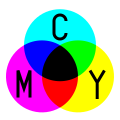Magenta
Magenta[edit]

Magenta is a color that is made by combining equal parts of red and blue light. It is a secondary color in the RGB color model, which is used to create colors on digital screens. Magenta is also a primary color in the CMYK color model, which is used in color printing.
History[edit]
The color magenta was first introduced in 1859, following the Battle of Magenta, a battle fought in the Italian War of Independence. The dye was originally called "fuchsine" but was later renamed "magenta" to commemorate the battle. The synthetic dye was one of the first aniline dyes, derived from coal tar.
Color Theory[edit]

In the RGB color model, magenta is created by mixing red and blue light at full intensity. It is located midway between red and blue on the RGB color wheel. In the CMYK color model, magenta is one of the four primary colors used in color printing, along with cyan, yellow, and black.
Magenta is complementary to green; when combined, these colors cancel each other out, producing a grayscale color. This is because magenta and green are opposite each other on the color wheel.
Perception[edit]

Magenta is not found in the visible spectrum of light. It is a non-spectral color, meaning it cannot be generated by a single wavelength of light. Instead, it is perceived by the human eye when red and blue light are combined. The perception of magenta is a result of the way our eyes and brain process light.
Applications[edit]
Magenta is widely used in art and design due to its vibrant and eye-catching nature. It is often used to create a sense of energy and excitement. In printing, magenta is a crucial component of the CMYK color model, allowing for the reproduction of a wide range of colors.
Cultural Significance[edit]
Magenta has various cultural associations. It is often associated with creativity, innovation, and non-conformity. In some cultures, magenta is seen as a color of harmony and balance.
Related Pages[edit]

Gallery[edit]
-
Linear visible spectrum showing magenta
-
Subtractive color model with magenta
-
Blended color wheel with magenta
-
Double fuchsias showing natural magenta
Ad. Transform your life with W8MD's Budget GLP-1 injections from $75


W8MD offers a medical weight loss program to lose weight in Philadelphia. Our physician-supervised medical weight loss provides:
- Weight loss injections in NYC (generic and brand names):
- Zepbound / Mounjaro, Wegovy / Ozempic, Saxenda
- Most insurances accepted or discounted self-pay rates. We will obtain insurance prior authorizations if needed.
- Generic GLP1 weight loss injections from $75 for the starting dose.
- Also offer prescription weight loss medications including Phentermine, Qsymia, Diethylpropion, Contrave etc.
NYC weight loss doctor appointmentsNYC weight loss doctor appointments
Start your NYC weight loss journey today at our NYC medical weight loss and Philadelphia medical weight loss clinics.
- Call 718-946-5500 to lose weight in NYC or for medical weight loss in Philadelphia 215-676-2334.
- Tags:NYC medical weight loss, Philadelphia lose weight Zepbound NYC, Budget GLP1 weight loss injections, Wegovy Philadelphia, Wegovy NYC, Philadelphia medical weight loss, Brookly weight loss and Wegovy NYC
|
WikiMD's Wellness Encyclopedia |
| Let Food Be Thy Medicine Medicine Thy Food - Hippocrates |
Medical Disclaimer: WikiMD is not a substitute for professional medical advice. The information on WikiMD is provided as an information resource only, may be incorrect, outdated or misleading, and is not to be used or relied on for any diagnostic or treatment purposes. Please consult your health care provider before making any healthcare decisions or for guidance about a specific medical condition. WikiMD expressly disclaims responsibility, and shall have no liability, for any damages, loss, injury, or liability whatsoever suffered as a result of your reliance on the information contained in this site. By visiting this site you agree to the foregoing terms and conditions, which may from time to time be changed or supplemented by WikiMD. If you do not agree to the foregoing terms and conditions, you should not enter or use this site. See full disclaimer.
Credits:Most images are courtesy of Wikimedia commons, and templates, categories Wikipedia, licensed under CC BY SA or similar.
Translate this page: - East Asian
中文,
日本,
한국어,
South Asian
हिन्दी,
தமிழ்,
తెలుగు,
Urdu,
ಕನ್ನಡ,
Southeast Asian
Indonesian,
Vietnamese,
Thai,
မြန်မာဘာသာ,
বাংলা
European
español,
Deutsch,
français,
Greek,
português do Brasil,
polski,
română,
русский,
Nederlands,
norsk,
svenska,
suomi,
Italian
Middle Eastern & African
عربى,
Turkish,
Persian,
Hebrew,
Afrikaans,
isiZulu,
Kiswahili,
Other
Bulgarian,
Hungarian,
Czech,
Swedish,
മലയാളം,
मराठी,
ਪੰਜਾਬੀ,
ગુજરાતી,
Portuguese,
Ukrainian


